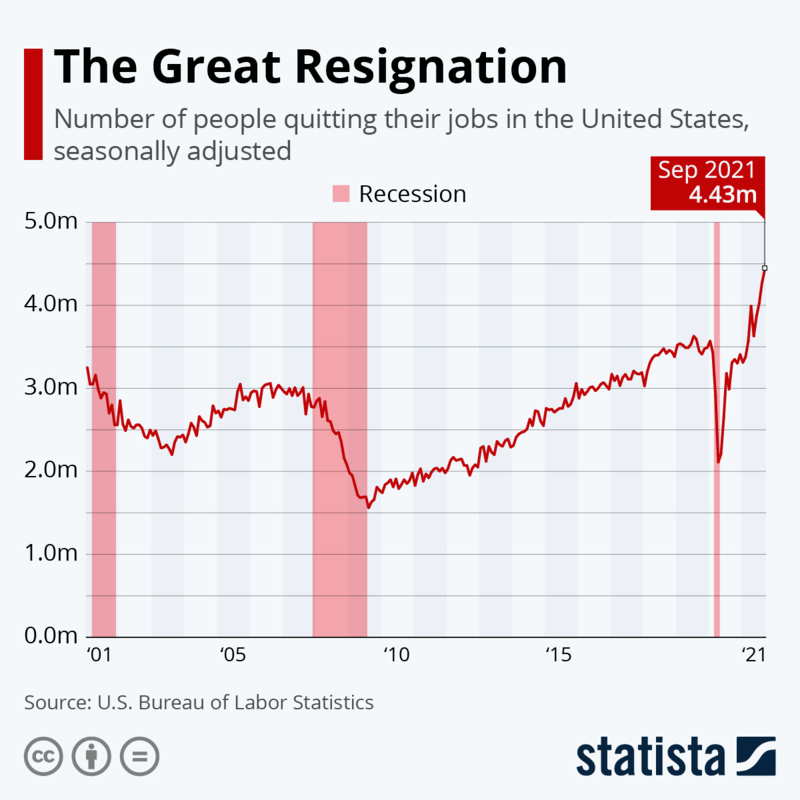We’ve been hearing about the “Great Resignation” for some time now, and it’s a very real concern for many businesses. Millions of employees are quitting their jobs, and this doesn’t seem to be slowing down any time soon.
Mass quitting is something that all businesses should be aware of, and it’s important to get a good grasp of the concept now to avoid your best workers suddenly leaving. Let’s just get something straight before we dive into it though – employers shouldn’t worry too much. As long as companies are offering the right workplace and motivation, mass resignations should not be a major concern.
We’ve put together a quick guide on the Great Resignation, as well as a couple of reasons to help businesses improve retention while everyone is quitting.
What is the Great Resignation?
The ‘Great Resignation’, also known as the ‘Big Quit’ has been happening since Spring 2021. Basically, millions of workers have been leaving their jobs, creating a huge surge of open positions. This is something that’s been happening mainly across the United States.
This mass Resignation has become a serious issue for many businesses, with August setting an all-time record for the number of people leaving their jobs. To be exact, 4.3 million people quit in August, which equals 3% of the US workforce.
The Bureau of Labor Statistics has noticed “quits”, as they call them, rising across all industries. And this doesn’t seem to be slowing down any time soon.
So, what exactly is going on here?

What is the Great Resignation All About?
There are a couple of reasons behind the Great Resignation. The main driving force seems to come from what workers experienced during the pandemic. Pre-pandemic, workers were generally happy with the way things operated, but after the pandemic, many reassessed their work-life balance.
With the whole world shifting to remote work, people discovered a new level of flexibility in their work schedules. This lead millions to quit their jobs to focus on new types of career opportunities and a new work-life balance.
Another reason that added to this mass resignation came from the stimulus payments and rise in unemployment benefits from Covid-19. This allowed many low-wage workers to stay at home.
People are quitting mainly due to job dissatisfaction and wanting to explore new opportunities. This is mainly visible in the younger generation, with more than half of Gen Z workers saying they are planning to find a new job within the next year.
The Great Resignation vs the ‘Great Reshuffle’
The Great Resignation is all about rethinking where and how employees work. However, there’s another factor to this – rethinking why employees work.
LinkedIn CEO, Ryan Roblansky, brings up an interesting point on this. He recently explained to Time that the number of people changing their positions on Linkedin over the current resignation period went up by 54% since the previous year.
He thinks this has more to do with “why” people work, as opposed to it just being about work from home rules or salary disappointments.
Microsoft CEO, Satya Nadella, said that he prefers the term “the Great Reshuffle” over “Resignation”. He says that employees are more focused on reshuffling themselves into positions that better align with who they want to be, instead of just quitting because of the way their company operates.

Who is Driving the Great Resignation?
While people are quitting their jobs across various industries, the main drivers behind the Great Resignation can be narrowed down to two main areas.
First of all, resignation rates are the highest among mid-level career employees. According to a study by Harvard Business Review, employees between the ages of 30 to 45 have had the biggest increase in resignation rates.
One possible reason for this is that there is less risk involved in hiring these mid-level career employees, and so they are presented with greater opportunities for remote work.
The other insight into the people behind mass quitting is that resignations are the highest in the tech and healthcare industries. This could be because employees who experienced an extreme rise in demand during the pandemic faced burnout which lead to resignations.
How to Improve Retention During the Great Resignation
The Great Resignation can affect all businesses and all industries. As a business owner, this can be a worrying thought. However, there are a few strategies that businesses can take to improve retention while everyone is quitting.
Give Employees More Value
One of the best ways to decrease the chances of employees quitting is to reframe the idea that employees have to work for their business. Going back to what Satya Nadella was saying about the “why” with people quitting, he explained that employers need to look beyond their work-from-home policies and job perks and focus on how workers’ values line up with their jobs.
By shifting the idea of work away from “working for a company” to having the company “work for you”, employees will find far greater job satisfaction. So if you want your business to compete in the world of the great reshuffle, then start to think about what deeper value you can add to your employees.
Be Flexible
Another major reason why so many people ended up quitting their jobs in the first place comes down to flexibility. Many workers now expect a high level of flexibility from employers – something that has resulted in many resignations.
So don’t just say your company is flexible – live up to that promise and include real flexibility in your operations.
Some businesses have taken flexibility to a new level by introducing four-day workweeks, while others simply allow for completely flexible working hours. With more people working online and from home, flexible work hours become far more achievable.
Involve a Human Connection
Even though the majority of people today want to work from home, we still all love having a human connection at work. In fact, this is one of the main things that businesses get wrong when introducing new work-from-home policies.
And no, we’re not talking about endless Zoom calls that could have been emails. One excellent way to bring the human element into remote workspaces is to use AI-enabled immersive meetings with 3D avatars.
Give teams the time to connect, bond, and build human relationships. Instead of just making work about work, bringing a real human element into it can help retention and job satisfaction in a big way.
Get the Basics Right
At the end of the day, employees work to earn a living wage and enjoy their working conditions. Before you start introducing unnecessary perks like office yoga classes and massage chairs, make sure you’ve got the basics right.
One of the most straightforward reasons behind the Great Resignation comes down to employees being fed up with dull working conditions and stagnating wages. Make sure your employees are getting all of their needs taken care of, and that your work environment is safe and fulfilling.
What we’ve seen in the mass quitting phenomenon lately is that workers are all feeling the same feelings of being fed up with their current working conditions. All the world needed was a push, such as the shift to mass remote work, to get people quickly dropping their jobs.

Conclusion
Millions of employees may be quitting their jobs, but this doesn’t mean it’s time for your business to panic. Just because there is so much career-changing taking place, you won’t necessarily be losing your entire workforce soon.
By understanding the motives behind mass resignations and ensuring your employee’s values are being taken care of, your business shouldn’t have any problems navigating this phenomenon. If you want to continue to thrive during the Great Resignation, the great reshuffle, or whatever you want to call it – then make sure your business is giving its employees what they’re looking for.
Related Content
- What’s Next for Remote Work? [Work Trends for 2021 and Beyond]
- The Rise of AI in Business
- The Rise of Augmented Reality
- The Pros and Cons of a 4 Day Work Week
- 7 Disruptive Marketing Tips to Win Over More Customers
- Should Your Business Accept Bitcoin?



